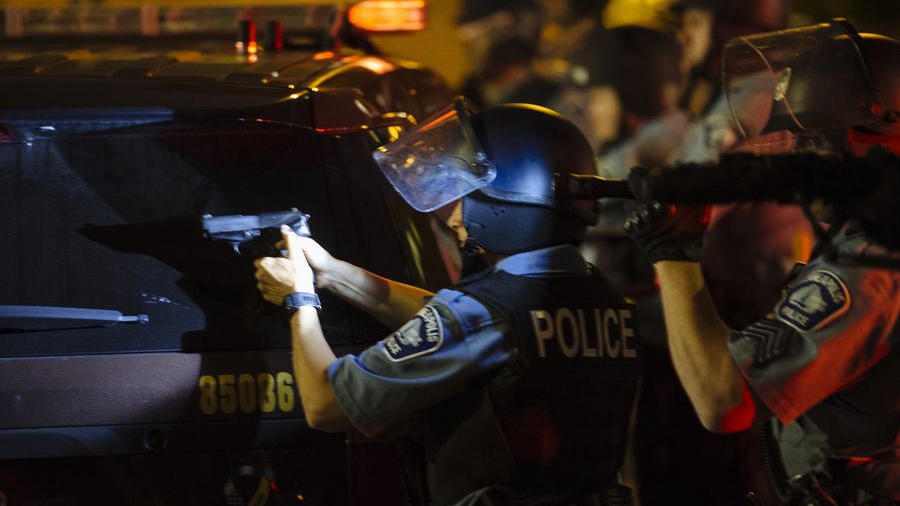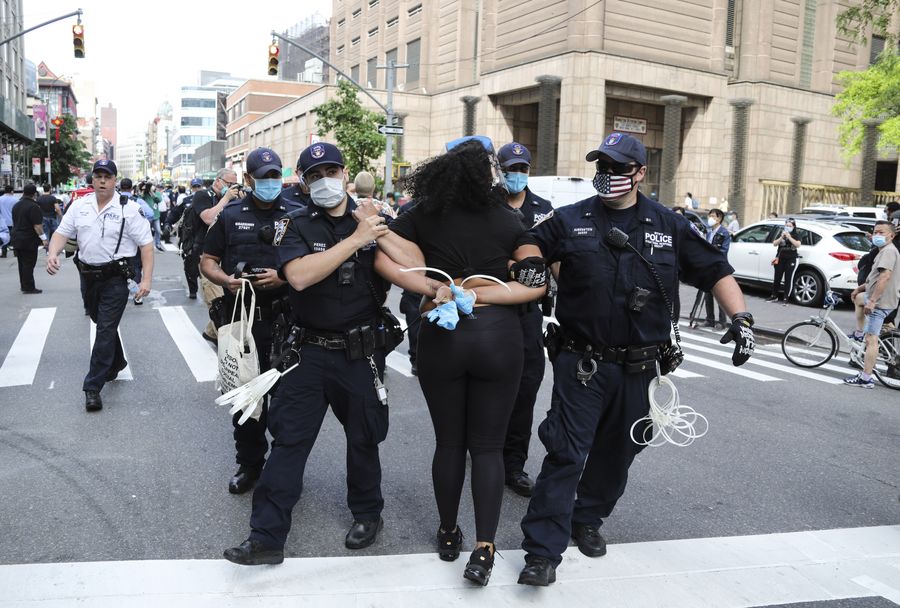
A police officer raises his gun during a protest against the death of George Floyd in Minneapolis, the United States, May 31, 2020. /Xinhua
A police officer raises his gun during a protest against the death of George Floyd in Minneapolis, the United States, May 31, 2020. /Xinhua
Editor's note: The article is translated from an analysis first published by CCTV.com on June 6, 2020. The article does not necessarily reflect the views of CGTN.
On June 5 local time in Washington D.C., a mural with the words "Black Lives Matter" was painted on a street in front of the White House. The city's mayor, Muriel E. Bowser, ordered the mural to show support for the racial justice movement.
Ever since police brutality in the city of Minneapolis led to the killing of George Floyd, an African-American man, people have been mourning him in their own ways.
On June 4, Floyd's family and hundreds of mourners gathered at the Northern Central University in Minneapolis to hold a memorial service. North Carolina, the state where Floyd was born, also held a service on June 6. Later on, Floyd's body will be transferred to Houston where he lived for public viewing on the June 8 and the funeral will take place on June 9.
In addition to expressing sorrow, for the past few days, people across the United States have continued to protest against police brutality and racial inequality, while also reflecting on the long-lasting issues of racial discrimination and police violence in the U.S. As the problem of unjust and violent treatment of African-Americans becomes increasingly glaring, various data and evidence of police brutality against black people are laid bare.
Fact check No.1: African-Americans have always been the biggest victims of police brutality
According to the New York Times, about 20 percent of the Minneapolis population is black, but when the police get physical, nearly 60 percent of the time the person subject to that force is black.
Since 2015, the Minneapolis police have documented using force about 11,500 times. For at least 6,650 acts of force, the subject of that force was black. By comparison, the police have used force about 2,750 times against white people, who make up about 60 percent of the population.
The report continued that the police in Minneapolis used force against black people at a rate at least seven times that of white people during the past five years. In the meantime, the data also shows that since 2015, police shooting and armed attacks in black communities of Minneapolis have been significantly higher than in other areas.
According to Vox, an American news and opinion website, decades of tensions between Minneapolis police and black communities have led to this moment. In 2015, an African-American man named Jamar Clark was shot dead after clashing with the police. In 2016, another black man named Philando Castile was shot dead while being pulled over during a traffic stop.

A protester is arrested by police on a street of lower Mahattan in New York, the United States, May 29, 2020. /Xinhua
A protester is arrested by police on a street of lower Mahattan in New York, the United States, May 29, 2020. /Xinhua
Fact check No.2: African-Americans are subject to police force more often than white people
Black people have always been the most frequent target of police force. According to the New York Times, in Minneapolis, black people were subject to 68 percent of the police's recent 171 gunpoint displays; 66 percent of the 1,748 acts of using chemical irritants. The same is true with other types of force used by police.
For example, the extremely dangerous "unconscious neck restraints" have been used 44 times in the past five years — 27 of those on black people. Statistically speaking, black people were found in more than half of all cases where force is used by police.
Some of the most thorough U.S. data comes from a study by the Justice Department published in November 2015: The study found that 3.5 percent of black people said they had been subject to nonfatal force — or the threat of such force — during their most recent contact with the police, compared with 1.4 percent of white people.
Fact check No.3: Inconsistent and inappropriate discipline of wayward officers caused the tragedy
Dave Bicking, a board member of Communities United Against Police Brutality, a Minnesota-based group, said that since 2012 more than 2,600 civilian complaints have been filed against Minneapolis police officers. But in only a dozen cases involving 15 officers has any discipline resulted from a civilian complaint alleging misconduct. The worst punishment was 40 hours of unpaid suspension.
Keith Mayes, an associate professor of African American and African studies at the University of Minnesota, said that when white people are the victims of deadly violence, the expected outcome is the arrest and conviction of the perpetrator; when black people are the victims of deadly violence by police, the expected outcome is a hope in things seldom seen and experienced in the legal system — especially the arrest, prosecution, conviction and sentencing of white officers.
In 2016, Castile announced, properly, that there was a licensed firearm in the car, after which, a police officer shot Castile seven times, with five bullets hitting him in the chest. The officer had asked Castile for his license, but later claimed Castile was reaching for the gun instead of the requested identification. However, the officer was eventually found not guilty.
Mayes said that a racially predictable way of seeking criminal justice results in the unequal distribution of social justice. In the same incident, black people are always treated unfairly. If such "white justice" persists, American justice will lose its credibility.
(If you want to contribute and have specific expertise, please contact us at opinions@cgtn.com.)